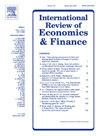Subjective probabilities under behavioral heuristics
IF 5.6
2区 经济学
Q1 BUSINESS, FINANCE
引用次数: 0
Abstract
We develop an approach to forming the subjective probabilities of future stock returns in the presence of multiple behavioral heuristics. This approach relaxes the assumption that behavioral heuristics are independent and makes it possible to investigate the individual effects as well as the joint effect of different behavioral heuristics on the investor’s probability assessment. In contrast to the objective probabilities, these subjective probabilities reflect the investor’s attitudes towards anticipated changes in the market conditions. They coincide with the objective probabilities when the investor is rational. To illustrate the use of this approach, we explore the implications of anchoring, overconfidence/doubt, and the availability heuristic for the predictability of individual stock returns based on past return data. We find empirically that the existing evidence against the random walk hypothesis may stem from the fact that the objective probabilities of large stock returns of either sign overstate the probabilities that the investor assigns to these returns given the market conditions that are anticipated to occur in the next period, which generates the “peso problem” in the data. Allowing for overconfidence in the subjective distribution of stock returns (induced by the anticipated decrease in the return volatility or the inability of the investor to adequately adjust the limits of the confidence interval away from the anchoring value) substantially decreases (compared with the case of the investor’s rationality) the degree, to which individual stock returns are predictable based on their past history, and, therefore, helps solve the stock return predictability puzzle.
行为启发式下的主观概率
我们开发了一种在多重行为启发下形成未来股票收益主观概率的方法。这种方法打破了行为启发式是独立的假设,使得研究不同行为启发式对投资者概率评估的个体效应和联合效应成为可能。与客观概率相反,这些主观概率反映了投资者对市场条件预期变化的态度。当投资者是理性的时候,它们与客观概率一致。为了说明这种方法的使用,我们探讨了锚定、过度自信/怀疑以及基于过去回报数据的个股回报可预测性的可用性启发式的含义。我们从经验上发现,反对随机漫步假设的现有证据可能源于这样一个事实,即任何一个标志的大股票回报的客观概率都夸大了投资者分配给这些回报的概率,给定下一时期预期发生的市场条件,这在数据中产生了“比索问题”。允许对股票收益主观分布的过度自信(由预期收益波动性下降或投资者无法充分调整偏离锚定值的置信区间的限制所引起)大大降低(与投资者理性的情况相比)基于其过去历史的个股收益可预测的程度,因此有助于解决股票收益可预测性难题。
本文章由计算机程序翻译,如有差异,请以英文原文为准。
求助全文
约1分钟内获得全文
求助全文
来源期刊
CiteScore
7.30
自引率
2.20%
发文量
253
期刊介绍:
The International Review of Economics & Finance (IREF) is a scholarly journal devoted to the publication of high quality theoretical and empirical articles in all areas of international economics, macroeconomics and financial economics. Contributions that facilitate the communications between the real and the financial sectors of the economy are of particular interest.

 求助内容:
求助内容: 应助结果提醒方式:
应助结果提醒方式:


